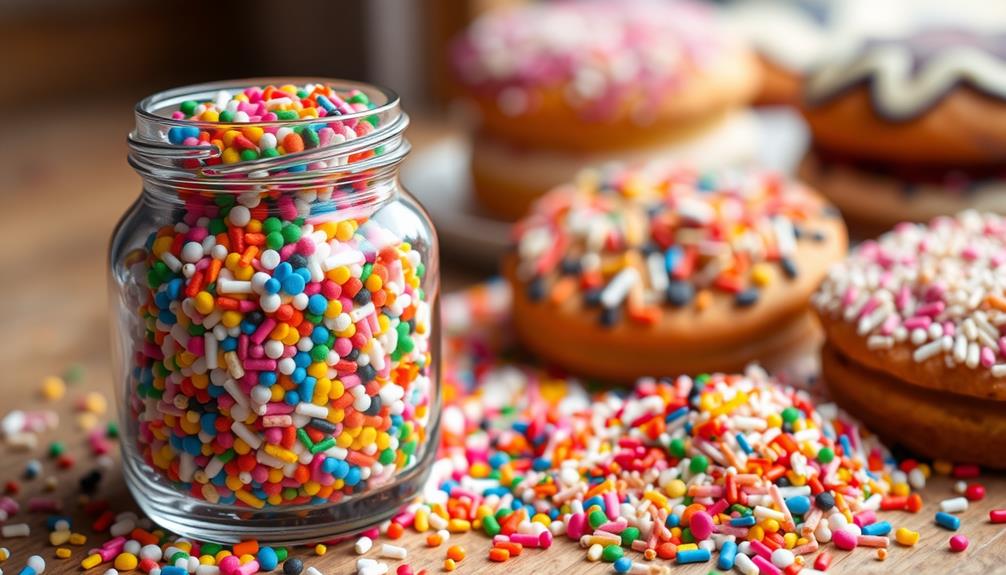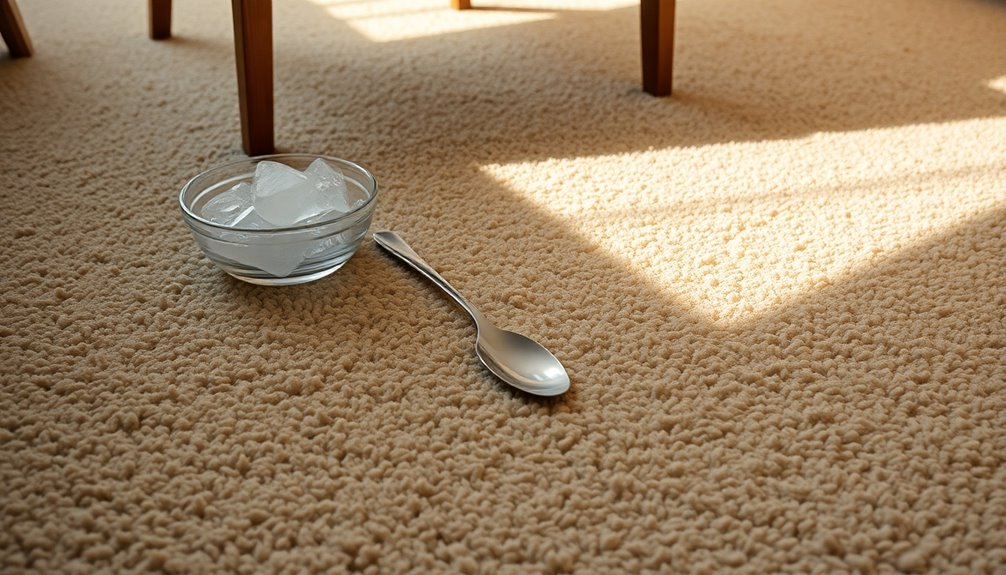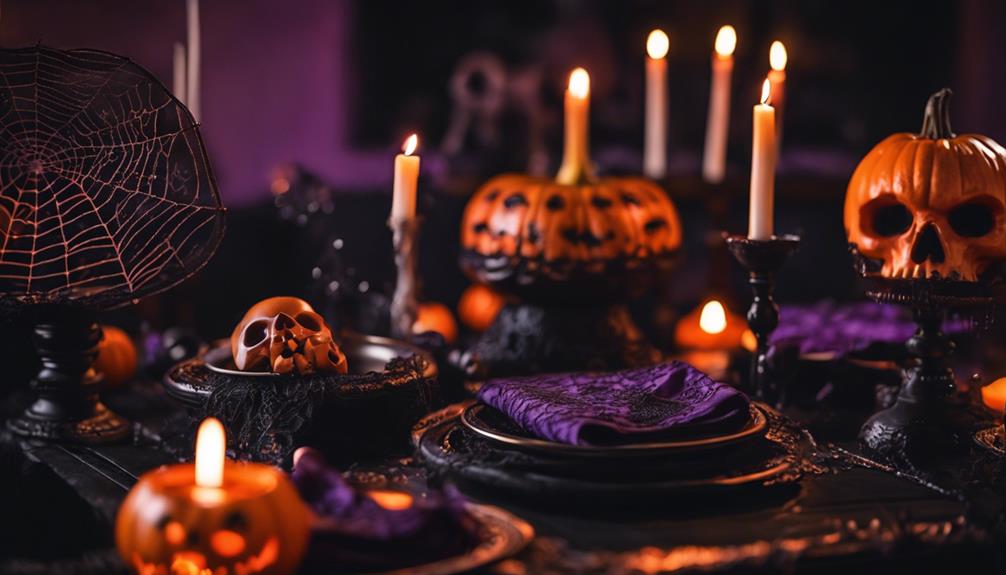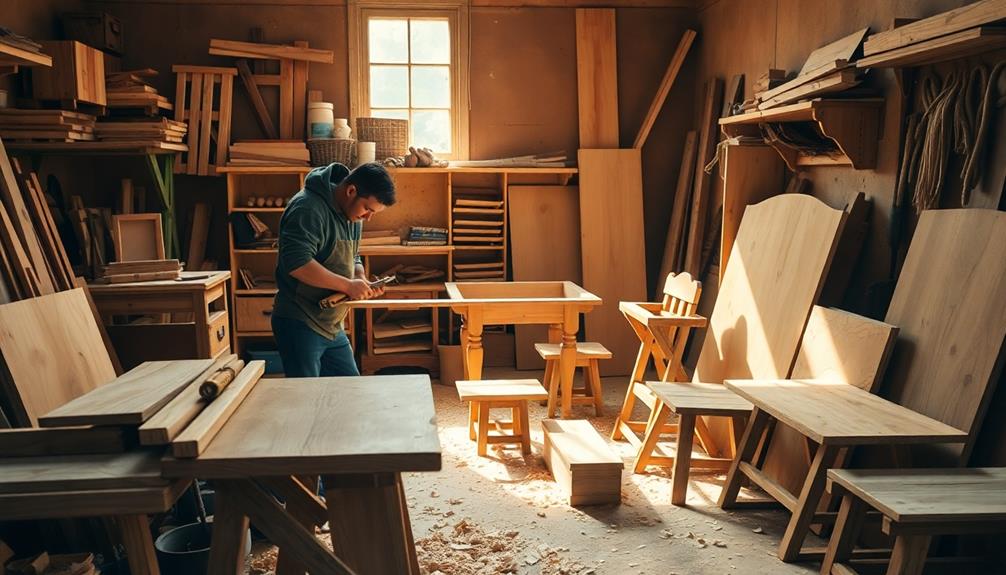To distress furniture, begin by lightly sanding the piece to eliminate any existing finish. Clean it thoroughly with a tack cloth, then apply your base coat using chalk or milk paint for optimal results. Once the paint has dried, selectively sand the edges and high-traffic areas to create a worn appearance. For added character, try techniques such as wet distressing or the two-tone method with petroleum jelly. Finish off with a protective coat like polyurethane or soft wax to enhance durability. Keep in mind, the key is to soften the edges and achieve an authentic appearance, and there is much more to discover about enhancing your distressed pieces. To achieve a unique distressed finish, consider incorporating techniques like dry brushing or layering different paint colors. Experiment with various distressing tools such as sandpaper, wire brushes, or even chains for a more natural and varied appearance. If you’re searching for a foolproof method to distress your furniture, take a look at our ink stain removal guide for tips and tricks on achieving that perfectly aged look. With the right tools and techniques, you can effortlessly transform any piece of furniture into a beautifully distressed masterpiece.
Key Takeaways
- Choose suitable paints like chalk or milk paint for easy distressing and a matte finish.
- Use tools like sandpaper and steel wool to create a worn look on furniture edges.
- Employ techniques like wet distressing or the two-tone method for unique results.
- Seal the distressed finish with polyurethane or wax for protection and durability.
- Focus on natural wear points, like corners and edges, for authentic distressing effects.
Understanding Distressed Furniture
Distressed furniture is all about creating a charming, aged look that adds character to your home. This style is intentionally weathered, giving pieces a unique, imperfect appearance that evokes a sense of history. By using techniques like sanding and paint stripping, you can achieve a beautiful distressed effect that transforms ordinary furniture into standout pieces.
Incorporating distressed furniture aligns perfectly with modern farmhouse decor trends, where natural materials and vintage aesthetics are celebrated.
You'll find that distressed furniture works beautifully within various styles, such as shabby-chic, rustic farmhouse, or vintage decor. This versatility allows you to mix and match distressed items with your existing decor, enhancing the overall aesthetic.
Common materials for distressing include wood, metal, and even plastic, making it possible to create a distressed look across a wide range of furniture types.
Keep in mind that not all furniture is suitable for distressing. Focus on items that naturally show wear or have historical significance, as these will yield the best results. Each distressed piece will have its own unique wear patterns, adding a personal touch to your home.
Embracing imperfect furniture not only enhances your decor but also tells a story, making your space feel warm and inviting.
Popular Distressing Techniques
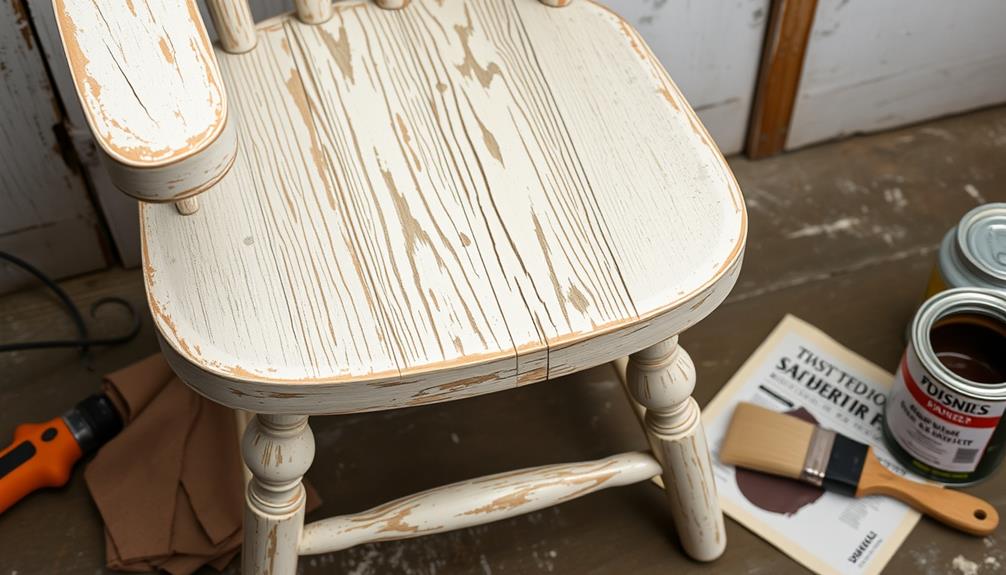
Now that you understand distressed furniture, let's explore some popular techniques you can use.
From wet distressing to creating a two-tone effect, each method adds unique character to your pieces. Incorporating elements like various brewing methods can inspire creativity in your distressing projects.
You'll also want to gather essential tools to achieve the best results in your distressing projects.
Popular Techniques Overview
When you want to give your furniture a unique, worn-in look, several popular distressing techniques can help achieve that desired aesthetic. One effective method is wet distressing, where you rub off the paint while it's still wet, creating a subtle, blended distressed look that mimics natural wear.
Incorporating elements from nature, such as using DIY Fire Pit Ideas to inspire your outdoor workspace, can enhance creativity during the distressing process. Another great option is the chalk paint method, known for its excellent coverage without the need for priming. This paint allows for a matte finish that can be easily distressed.
If you're aiming for a lighter appearance, consider the whitewash technique. By mixing white paint with water, you can create a solution that lends an airy feel to raw or stained wood surfaces.
For a more dramatic effect, try the two-tone method using petroleum jelly. Apply it to areas where you want the base coat to show, then add a contrasting color. Once lightly sanded, this reveals the underlying layer beautifully.
Lastly, inflicting damage can enhance authenticity. Utilizing tools like hammers or wire brushes lets you create random dents and gouges, giving your piece a genuinely aged and worn look.
These techniques make DIY distressing both fun and rewarding!
Essential Tools Needed
To successfully distress furniture, you'll need a few essential tools that make the process smoother and more effective. Having the right tools not only saves you time but also guarantees a high-quality finish. One essential tool for distressing furniture is sandpaper of varying grits, which allows for a smooth and even finish. Additionally, a good quality paintbrush is crucial for applying paint and achieving the desired distressed look. Lastly, investing in high-quality upholstery foam can improve sofa bed comfort, making the furniture both aesthetically pleasing and comfortable for everyday use. These tools, along with others, are essential for achieving the perfect distressed furniture look.
Here's a quick list of what you'll need:
- Medium-grade steel wool: Perfect for achieving a worn look and softening edges.
- Sandpaper: Different grits will help you control the wear level of your furniture.
- Painting tools: Brushes and foam rollers are essential for smooth application of base and top coats.
- Distressing mediums: Items like chains, hammers, or wire brushes can inflict controlled damage.
- Protective finish: Optional materials like polyurethane will add durability while preserving your distressed look.
With these essential tools, you're well on your way to transforming ordinary furniture into unique, character-filled pieces.
Remember to practice your techniques on scrap materials first to find the right methods and effects that suit your style.
Happy distressing!
Essential Tools and Materials
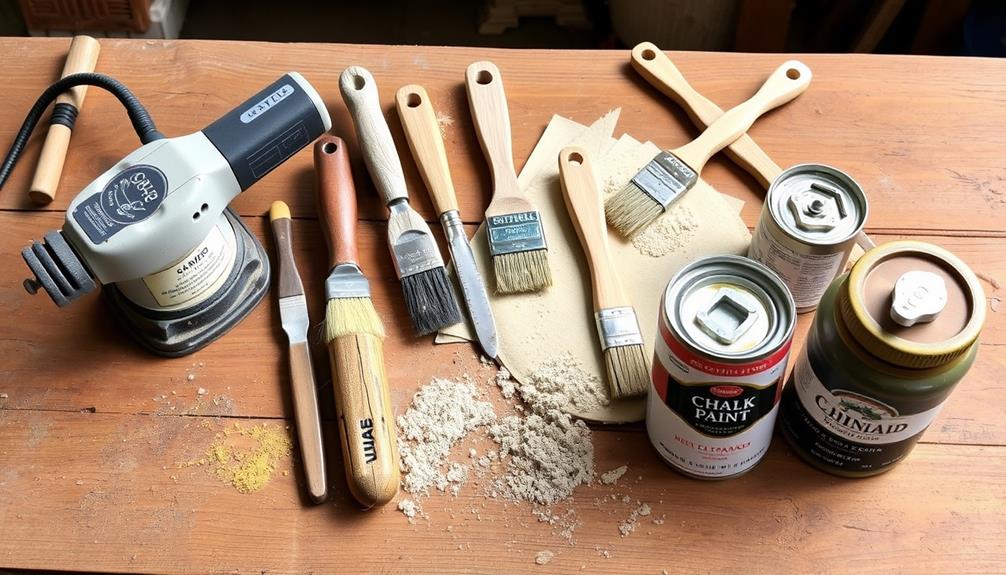
To get started with distressing furniture, you'll need a few essential tools and materials.
Medium-grade steel wool and sandpaper will help you achieve that worn look, while satin latex paint is your best bet for a smooth finish.
Don't forget about optional finishing products like polyurethane to protect your newly distressed piece.
Required Tools Overview
Distressing furniture requires a few essential tools and materials that can make your project both enjoyable and successful. Having the right tools at your fingertips will help you achieve the perfect look for your wood furniture.
Here's a quick overview of what you'll need:
- Painting brushes and rollers: For applying base and top coats of paint.
- Medium-grade steel wool and sandpaper: To create that desired wear and tear on the furniture surface.
- Tack cloth: Essential for wiping down surfaces after sanding, ensuring a clean base for painting.
- Chains or hammers: These optional tools can add unique textures and character to your pieces.
- Polyurethane: A protective finish that enhances durability after distressing.
With these tools and materials, you'll be well-prepared to give your furniture a beautifully distressed look.
Remember, the right paint and technique can transform your wood furniture into a stunning piece that reflects your personal style.
Recommended Paint Options
With your tools gathered, the next step is selecting the right paint to achieve that perfect distressed look. Chalk paint is a fantastic choice; its matte finish allows for easy manipulation, making it ideal for distressing. Popular brands like Annie Sloan's Old White and Rust-Oleum provide excellent coverage and are budget-friendly.
If you're aiming for a rustic vibe, consider using milk paint. General Finishes milk paints are known for their premium quality and work beautifully for creating a weathered appearance, while still being easy to distress.
For a more versatile option, satin latex paint can serve as both a base and top coat. Its durability means you can sand it down to reveal layers beneath, giving you that layered distressed effect.
Lastly, don't forget that using a resist like petroleum jelly can help you achieve a stunning two-tone effect by allowing you to control where the base coat shows through.
With these options in hand, you're well on your way to transforming your furniture into a beautifully distressed piece.
Finishing Products Explained
Achieving a stunning distressed look requires careful attention to the finishing products you choose. The right materials can enhance the beauty and durability of your furniture, ensuring it lasts for years.
Here's a quick overview of essential finishing products:
- Polyurethane: Adds protection and durability, keeping your distressed surfaces intact.
- Soft Waxes: Available in various colors, these seal your furniture while enhancing its depth. Clear wax provides a lovely satin finish.
- Finishing Creams: Offer a range of sheens, allowing you to customize the look of your piece to match your vision.
- Burnishing Products: Help create an aged patina effect, adding authenticity and ensuring a smooth finish.
- High-Quality Materials: Always opt for products designed specifically for distressing to avoid peeling or uneven finishes.
Step-by-Step Distressing Process
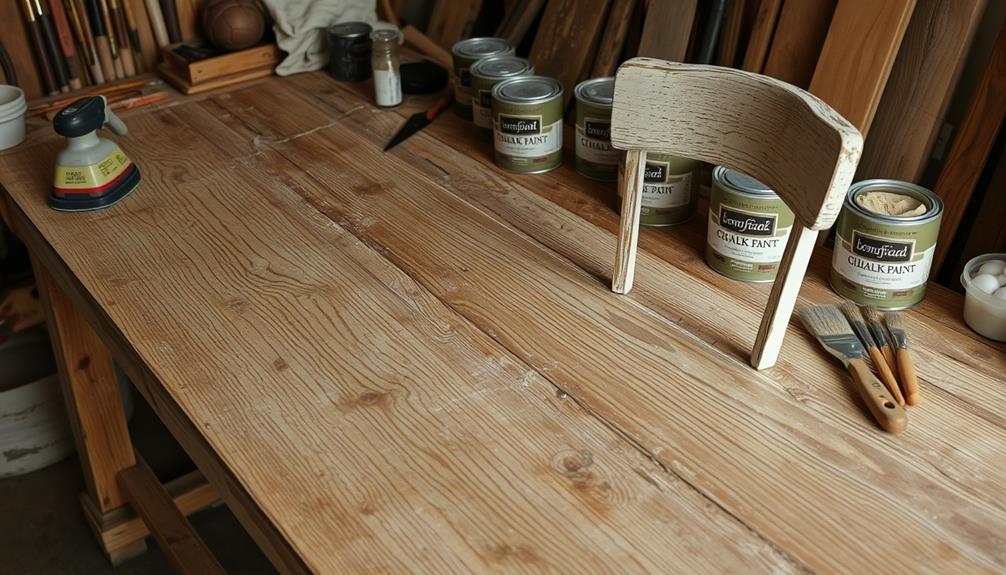
To start the distressing process, you'll want to prepare your furniture by lightly sanding it to remove any existing finish. This guarantees a clean surface for painting.
After sanding, wipe the piece down with a tack cloth to eliminate dust and debris. Next, apply a base coat color evenly across the entire piece and let it dry completely before moving on.
If you're aiming for a bare-wood look, use sandpaper to gently distress specific areas. For a colored finish, apply candle wax to the spots where you want the base coat to show through.
Once that's done, paint over the base coat and wax. After it dries, sand the surface again, focusing on edges and high-wear areas to create a natural distressed finish.
Choosing the Right Paint
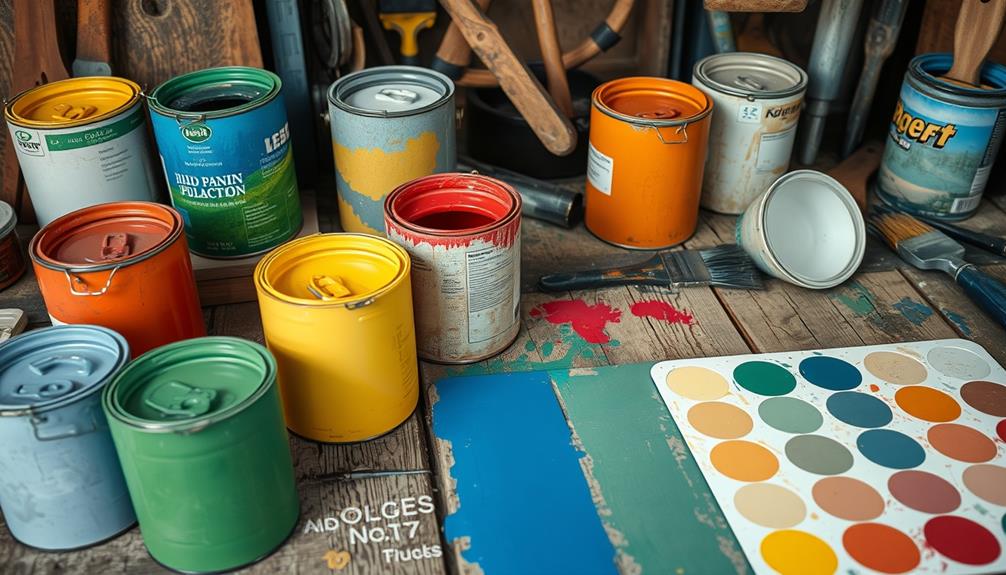
When you're choosing the right paint for your distressing project, consider materials like chalk or milk paint for the best results.
These options not only offer a matte finish but also allow for easier manipulation during the distressing process.
Paint Type Selection
Selecting the right paint is essential for a successful distressing project. When you choose the appropriate paint, you'll set the foundation for achieving that perfect distressed furniture look. Here are some options to take into account:
- Chalk Paint: Easier to manipulate and offers a matte finish without priming, making it ideal for distressing.
- Milk Paint: Known for its exceptional finish and durability, perfect for long-lasting furniture.
- Rust-Oleum Chalked Paint: A budget-friendly option that provides great results, perfect for DIYers.
- Annie Sloan Chalk Paints: A premium choice, favored by professionals for high-quality performance.
- Avoid Regular Latex Paint: It can peel and create undesirable finishes during the distressing process.
Ultimately, chalk paint and milk paint are your best bets for achieving that vintage, worn look without the hassle.
By steering clear of regular latex paint, you'll guarantee that your distressing efforts yield beautiful results.
Choose wisely, and you'll be well on your way to transforming your furniture into stunning pieces that showcase your unique style!
Application Techniques Tips
Applying paint correctly is vital for achieving that coveted distressed look on your furniture. For the best results, consider using chalk paint or milk paint. These options are easy to manipulate and create a matte finish perfect for aging techniques.
Rust-Oleum chalked paint is a budget-friendly choice, while Annie Sloan's chalk paints are known for their high quality. If you're looking for premium products, General Finishes milk paints offer exceptional finishes ideal for detailed distressing projects.
Avoid regular latex paint, as it can peel during the distressing process and won't give you the aged look you want. When selecting a paint, think about the finish and coverage. Chalk paint typically requires no priming and provides excellent coverage, making it a breeze for furniture painting.
Before you begin, make sure your piece of furniture is clean and free of any old wood stain. This prep work helps the paint adhere better and enhances the overall finish.
Styles for Distressed Furniture
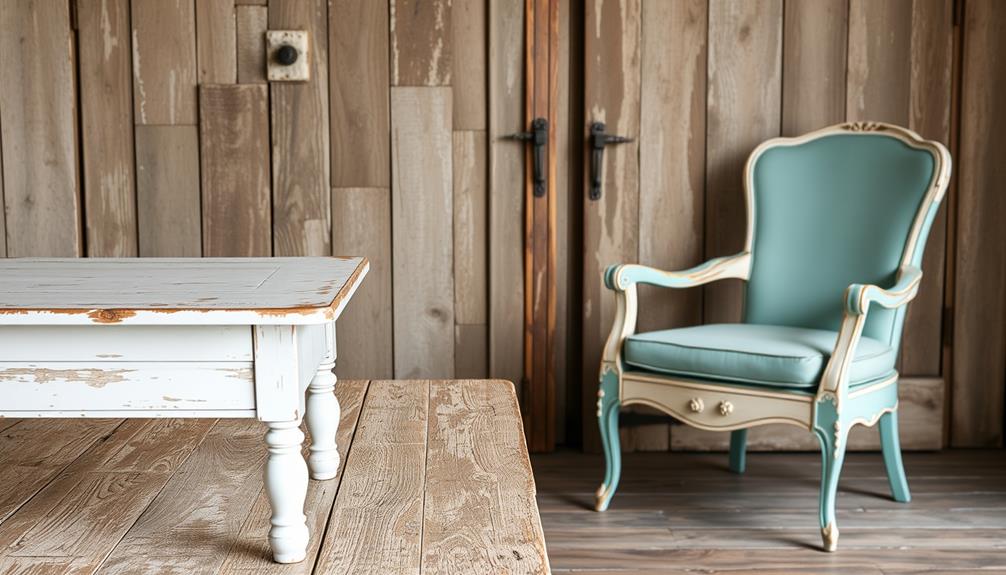
Distressed furniture styles evoke a sense of nostalgia, breathing life into your home with warmth and character. By choosing to distress furniture, you can create a unique aesthetic that resonates with various design preferences.
Here are some popular styles to contemplate:
- Shabby-Chic: Soft colors and vintage patterns highlight the beauty of imperfect wood.
- Rustic Farmhouse: Weathered finishes and rugged charm bring a cozy, country feel to your space.
- Mid-Century Modern: Distressing these classic pieces adds character while retaining their authenticity.
- Vintage: Antique furniture, especially heirlooms, gains a personal touch and historical significance through distressing.
- Primitive Lodge: Buffets and tables with a weathered look enhance lodge-style decor, creating a warm atmosphere.
Combining distressed styles with modern elements allows you to customize your decor, making it versatile and inviting.
Whether you prefer the rustic appeal of a farmhouse table or the elegant charm of shabby-chic, distressed furniture offers a way to express your style while celebrating the beauty of age and wear.
Embrace the imperfections, and watch your home transform into a cozy retreat.
Decorating With Distressed Pieces

Incorporating distressed furniture into your home can instantly elevate your decor, creating a warm and inviting atmosphere. These pieces, like weathered wood frames or vintage buffets, can serve as stunning focal points, adding depth and character to any room.
You'll find that mixing distressed furniture with modern elements creates a visually appealing contrast, enhancing the overall aesthetic and providing a cozy vibe.
To achieve a cohesive design, consider using distressed items in specific areas. For example, crackle-finished urns or whitewashed cabinets work wonderfully in farmhouse-themed kitchens or living areas. They evoke a sense of nostalgia while fitting seamlessly into your decor.
Accent pieces, such as distressed chairs or side tables, are easy to integrate into your existing setup. They can refresh your space without requiring a complete overhaul, bringing a touch of rustic charm that balances out contemporary styles.
Common Mistakes to Avoid
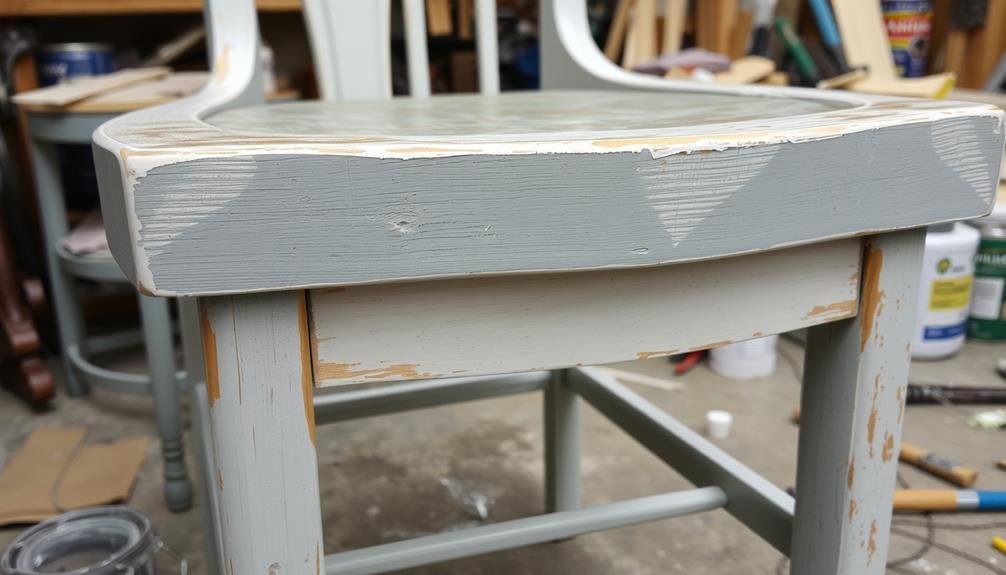
When you're trying to achieve that perfect distressed look, there are several common mistakes you should watch out for. Avoiding these pitfalls will help you create a beautifully aged piece with authenticity and charm.
- Don't use low grit sandpaper (60 or 80 grit). It can create rough textures that detract from the desired distressed appearance.
- Refrain from excessive distressing; subtlety is key. Overdoing it can make your piece look artificially worn.
- Don't overthink the process. Keeping it simple and intuitive often leads to an organic and successful outcome.
- Resist the urge to distress every surface. Focus on logical wear points, like edges and corners, to maintain authenticity.
- Understand that once you distress a piece, reversing the effect is challenging. Proceed with caution and evaluate your results frequently.
Sealing and Finishing Techniques
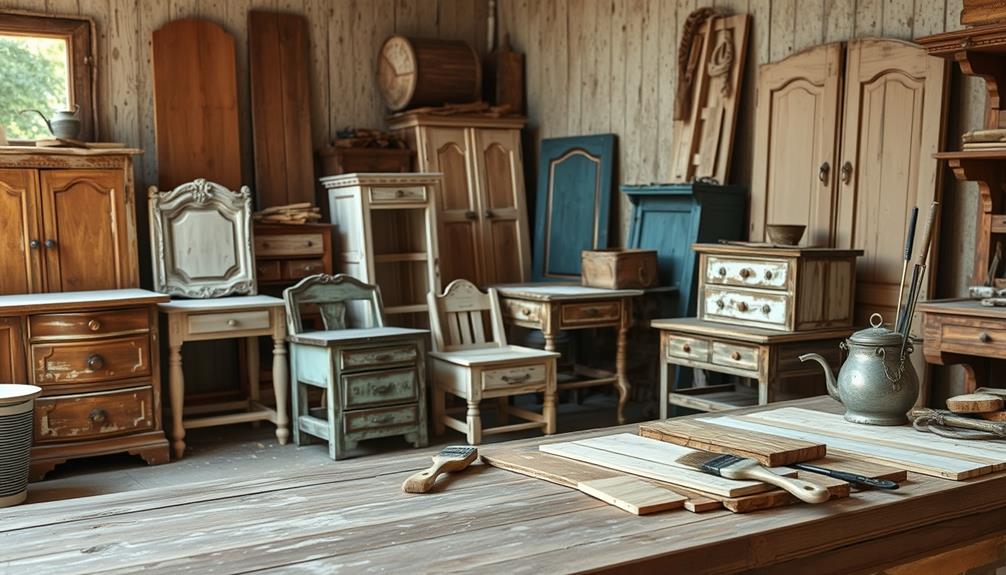
To keep your newly distressed furniture looking its best, sealing and finishing techniques are essential. You have several options to protect and enhance your piece. A soft clear wax gives a satin finish while preserving the aged look, providing a barrier against wear and tear. Alternatively, oils like mineral oil or tung oil penetrate the wood, enhancing its grain for a natural finish.
When sealing distressed surfaces, consider a polyurethane top coat for added durability, especially on high-traffic items. Just remember, it might alter that desired matte finish. For food-contact items, a soapstone sealer wax is your best bet, as it's food-safe and still protects your distressed finish.
Here's a quick comparison of sealing options:
| Sealing Method | Finish Type | Best For |
|---|---|---|
| Soft Clear Wax | Satin | General protection |
| Mineral/Tung Oil | Natural | Enhancing wood grain |
| Polyurethane Top Coat | Durable, Glossy | High-traffic furniture |
| Soapstone Sealer Wax | Food-safe, Matte | Food-contact items |
Always allow 24 hours of drying time between coats to guarantee proper curing and effectiveness.
Learning Resources and Inspiration
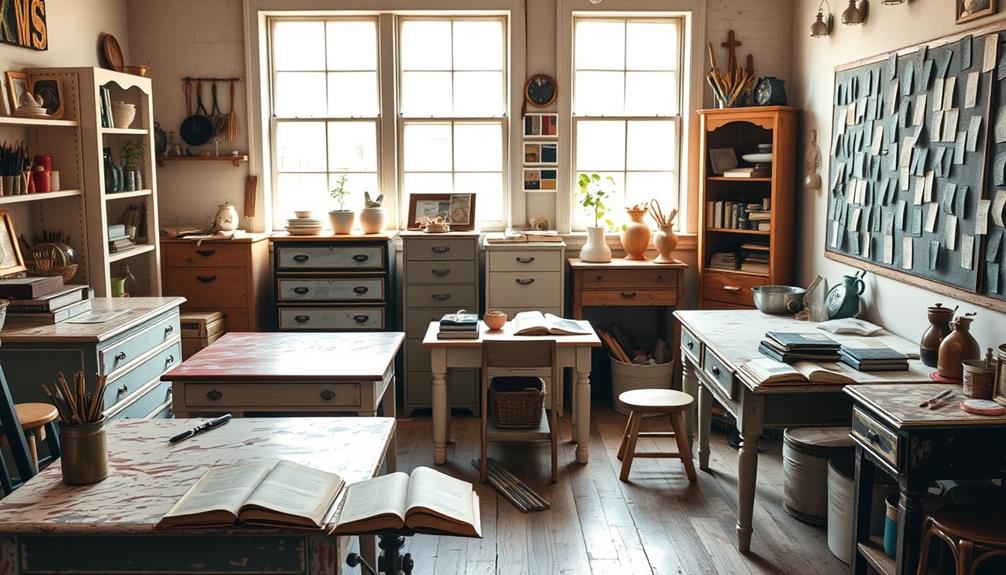
A wealth of learning resources and inspiration awaits you as you commence on your furniture distressing journey.
With the right guidance, you'll discover various distressing techniques that can elevate your projects. Here are some great places to start:
- YouTube Tutorials: Check out channels like "Artistic Distressing" and "Distressed Coffee Table" for visual demonstrations of techniques.
- DIY Blogs and Forums: Immerse yourself in online blogs and communities that offer step-by-step guides and tips from fellow DIY enthusiasts.
- Product Websites: Explore sites like Real Milk Paint Co. and Annie Sloan for detailed descriptions of products ideal for distressing.
- Local Workshops: Join hands-on classes in your area to learn directly from experienced artisans and gain valuable skills.
- Pinterest Inspiration: Browse Pinterest for a treasure trove of ideas and styles that can inspire your own unique projects.
Frequently Asked Questions
What Is the Easiest Way to Distress a Piece of Furniture?
The easiest way to achieve a distressed look is by using chalk paint. You can simply sand certain areas or apply petroleum jelly before painting, letting the base color peek through for an effortless, worn appearance.
What Kind of Paint Is Used for Distressing Furniture?
You'll want to use chalk or milk paint for distressing furniture. Chalk paint's easy to manipulate, while milk paint provides a premium finish. Avoid regular latex paint, as it won't give you the desired look.
Can You Distress Furniture Without Sanding?
Yes, you can definitely distress furniture without sanding. Techniques like using petroleum jelly, damp rags, or dry brushing let you achieve that worn, vintage look without the mess and effort of traditional sanding methods.
What Sandpaper to Use for Distressing Furniture?
When you're selecting sandpaper for distressing, use medium-grade options like 120 to 220 grit. Start with 120 for initial distressing, then switch to 220 for finer detailing. Always sand with the wood grain for best results.
Conclusion
Now that you're equipped with the knowledge to distress furniture, imagine the character and charm you can add to your home with just a few simple techniques. Don't shy away from experimenting—each piece you transform tells a unique story. Remember, the beauty of distressed furniture lies in its imperfections. So, roll up your sleeves and let your creativity flow; your next masterpiece is just a brushstroke away!

